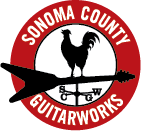Have you ever had an instrument that you love and have played for 25 years, but that always has one thing that really bugs you? Maybe the pickguard? The color? The hardware finish? Things like the hardware, pickups, pickguard and electronics are pretty easy to change. If you want to go to a different body color, different fret size or different pickup number/size, then things start getting more complicated. What if you have a Rickenbacker 4003 and you don’t like the triangular fretboard inlays? Most folks just live with it. What else can you do? It would be impossible to fill the triangles and then dot the neck invisibly. The fretboard is lacquered and bound, so a replacement is out of the question. Or is it?
Because of the Rickenbacker truss rod repair post on our website, we get calls from all over the country about various Rick issues. Our customer Rock, who lives in Conn., emailed us about his 4003. He had owned the bass for 25 years, and had never liked the triangle inlays. When he asked us if we could replace them with dots, I decided to determine exactly what it would take, no matter how complicated or costly, and let him decide whether or not he wanted to pursue it. Turns out, he had asked several shops over the years to do this job, but no one wanted to try it. After we went through the steps I thought it would take, and then talked cost, he decided to ship us the bass.
I first took pictures and measurements. I needed to know exactly how the binding fit, how the fingerboard wood looked, how thick the neck was and exactly where the 12th fret lined up on the neck shaft. All these details would be critical in delivering a bass back to him that looked factory and that played and felt the way it had for so many years.
After the measurements were taken, I pulled the frets, scored the lacquer along the binding line, and put the bass in the Plek.
I used the Plek to plane the fingerboard off, including the triangle inlays. I programmed the Plek to take .125″ off on each side of the fingerboard, leaving me a perfectly flat board, with a .040″ tall bit of side binding intact.
With the bass out of the Plek, the next step was to pull the small strip of binding off. This was a critical part of the process, as any damage to the blue finish would be very hard to fix. I scored along the finish between the binding and the neck shaft, then used a hair dryer to gently heat the plastic binding so that I could remove it. It came off without any damage to the original finish, and left a nice, crisp binding ledge.
I took measurements of the remaining fingerboard, and duplicated it using a piece of bubinga I got from Joe Zon. The fingerboard had to be sized so that when it was glued on, it would make a perfect continuation of the remaining original board. This would allow for a smooth, even glue surface for the binding. To size the wood to the tolerance necessary, I went old school and broke out the hand planes. It’s great to have the Plek and all the power tools, but when wood has to fit exactly, it really comes down to sharp blades pushed by hand. I can take off as little as .0005″ in a pass and slowly creep up to the finished dimension.
To glue on the board, I used really big rubber bands as a clamp. It was the first time I had glued a board that way, and I’ll do it that way from now on. The bands centered the board nicely, and I used a small block of wood at the body end of the board to keep it from slipping.
When the glue was dry, I removed the rubber bands and cleaned up the binding ledge. The transition between the original fingerboard and the new one was fantastic, which was great, since the binding was the key to this whole operation. By leaving a bit of the original fingerboard intact, I was able to preserve the original binding ledge so that I could rebind exactly as it was, and also cover the seam between the old and new fingerboards. At this point, I rigged up a little scraper holder so that I could thin the binding. I wanted to thin it so that it would sit a little low where it butted up against the original finish. This would allow me to build up lacquer on the binding, bringing it level with the original finish so that I didn’t have a bulge of lacquer on the binding.
After I got it to the thickness I wanted, I glued the binding on by taping it into the binding channel, leaving small gaps between the tape pieces. I then wicked thin super glue between the binding and wood, being sure the binding was down tight. After wicking between the tape pieces, I removed the tape and finished wicking along the entire binding line to be sure there were no gaps between the binding and the board.
With the fingerboard now ready for frets, I cut the fret wire to length, undercut the fret tangs, pressed and glued the frets into the board and bevelled and polished the ends to get it ready for finish.
Mike started the finish work by brushing lacquer onto the binding to build it up to the level of the original finish. After there was sufficient build, he masked just below the binding line and shot the fingerboard and binding with nitro. We waited about three weeks for the lacquer to cure, and then wet sanded and buffed it.
The lacquer had to be scraped off the fret tops, then the bass was strung up and put back in the Plek for the final fret leveling. After polishing the frets and reinstalling the electronics, the setup was completed and the bass was ready to go.













